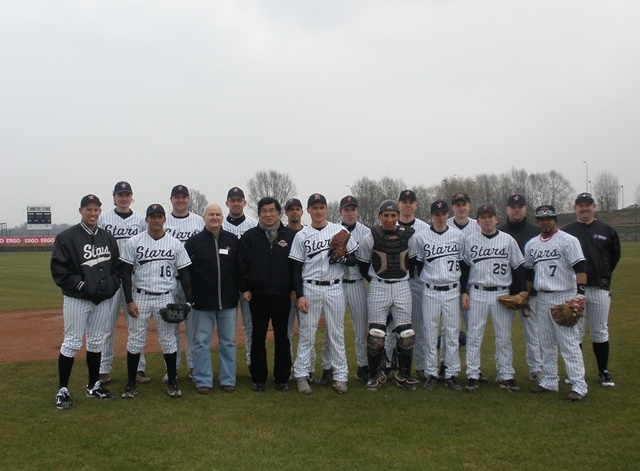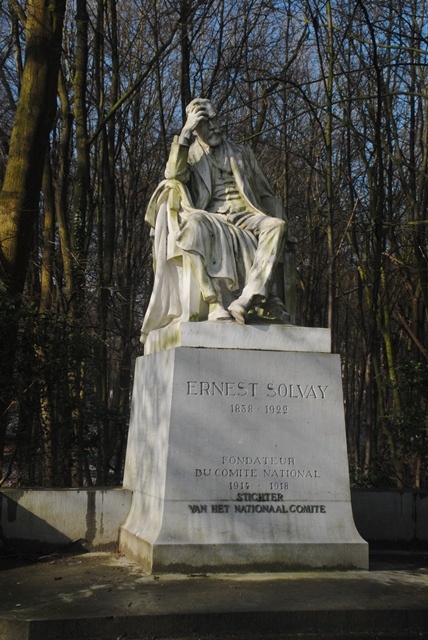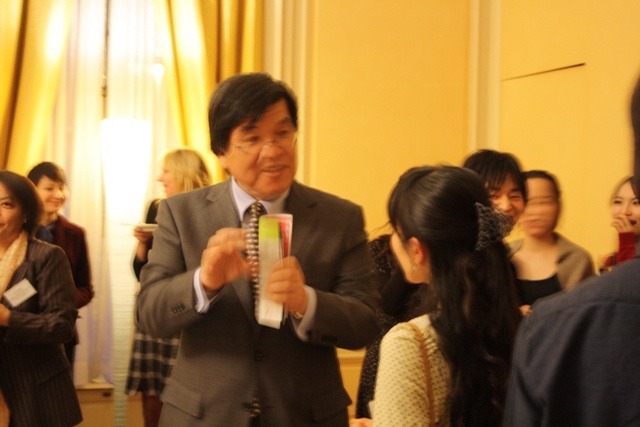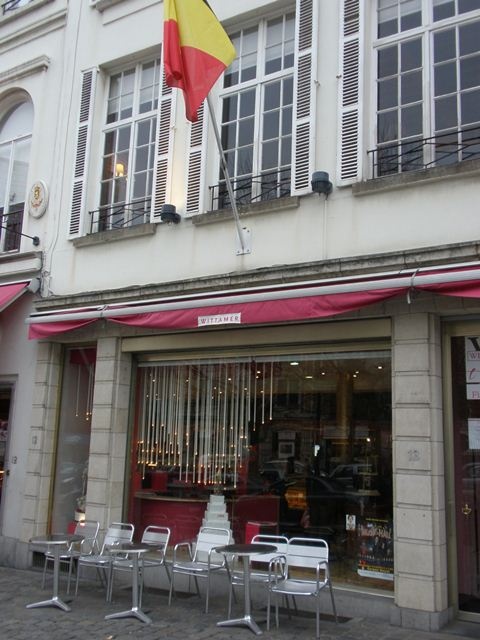The First Japanese to Visit Belgium (No.13)
 The other day, I had a talk with Jérôme Legris, President of the Belgian Federation of Baseball and I learned that there are 3000 baseball players in Belgium. Of course, they are all amateur players. A total of 28 teams, from the 1st division to the 3rd division, belong to the leagues and they play throughout the year. The 1st division, consisting of 8 teams, play every Sunday from April to September two games. After 5 months (after 42 round-robin games), the winning team is decided by the two top teams through the Belgian series. In recent years, the Hoboken Pioneers of Antwerp have always won the championship, but they are around 30th in the European ranking, so there’s still work to be done. The International Easter 2013 Baseball Tournament, which is the first international game of this season, was held in Antwerp last weekend and I was asked to throw the first ball. The participating teams were the “Mortsel Stars” from Belgium, strong teams from the Netherlands and France and Finland’s national team. The venue was Luchthavenlei Baseball Field south of the airport, but there were no stands for spectators both infield and outfield. It is what we call in Japan a grass-lot baseball field. The 4 team round robin results showed the French team, undefeated in the three games, as the winner of this tournament and the “Mortsel Stars” were 2nd with 2 victories and 1 defeat. Not many Belgians know that a baseball league takes place in Belgium to begin with and it is not really a topic among the Japanese residents in Belgium either. As a matter of fact, the Belgian young baseball players (of course, they used a hardball) are very serious. Speaking of baseball in Europe, I can only think of the Netherlands and Italy. Belgium, however, was the first country to host the European baseball championship in 1954 and they even won in 1967 (though Belgium was ranked 9th in the championship last year, which was 4th from the bottom). President Legris told me that a priority issue for Belgian baseball is to improve the quality of the current players instead of increasing the number of players and that it is a sad fact that it is even difficult to secure good coaches and umpires. Hang on, Belgian Baseball! The other day, I had a talk with Jérôme Legris, President of the Belgian Federation of Baseball and I learned that there are 3000 baseball players in Belgium. Of course, they are all amateur players. A total of 28 teams, from the 1st division to the 3rd division, belong to the leagues and they play throughout the year. The 1st division, consisting of 8 teams, play every Sunday from April to September two games. After 5 months (after 42 round-robin games), the winning team is decided by the two top teams through the Belgian series. In recent years, the Hoboken Pioneers of Antwerp have always won the championship, but they are around 30th in the European ranking, so there’s still work to be done. The International Easter 2013 Baseball Tournament, which is the first international game of this season, was held in Antwerp last weekend and I was asked to throw the first ball. The participating teams were the “Mortsel Stars” from Belgium, strong teams from the Netherlands and France and Finland’s national team. The venue was Luchthavenlei Baseball Field south of the airport, but there were no stands for spectators both infield and outfield. It is what we call in Japan a grass-lot baseball field. The 4 team round robin results showed the French team, undefeated in the three games, as the winner of this tournament and the “Mortsel Stars” were 2nd with 2 victories and 1 defeat. Not many Belgians know that a baseball league takes place in Belgium to begin with and it is not really a topic among the Japanese residents in Belgium either. As a matter of fact, the Belgian young baseball players (of course, they used a hardball) are very serious. Speaking of baseball in Europe, I can only think of the Netherlands and Italy. Belgium, however, was the first country to host the European baseball championship in 1954 and they even won in 1967 (though Belgium was ranked 9th in the championship last year, which was 4th from the bottom). President Legris told me that a priority issue for Belgian baseball is to improve the quality of the current players instead of increasing the number of players and that it is a sad fact that it is even difficult to secure good coaches and umpires. Hang on, Belgian Baseball!
< The Success Story of a Man Called Ernest Solvay >
 Near my residence, at the entrance of the Forest of La Cambre, there’s a statue of a gentleman sitting down, lost in thought. It is an almost life-size statue and on the base is engraved “Ernest Solvay, Founder of National Committee 1914 - 1918”. He was the founder of “the Solvay Group” which brought him enormous wealth by the production and sale of chemical products at the end of the 19th century. This great personality is known by every Belgian as the businessman who donated his private fortune to rescue his compatriots that were suffering under the German occupation during World War I. He was raised by his father who ran a salt making business. Suffering from pleurisy at the age of 18, he was not able to go university and he started to work at his uncle’s gas company. In 1861, when he was 22 years old, he happened to discover the formula to mass-produce soda ash, thus paving the way to produce various chemical products such as soap, glass, aluminium and fibre material in large quantities at the factory. At the age of 25, he started a business with his younger brother. In the first 10 years, he established new methods for producing a variety of chemical products and also set up many factories abroad. After that, the company reached the top and I probably do not need to talk about his later life in details. He always said that “money-making is a means and not an end”. The fact that he was aware of corporate social responsibility and that he and his wife were committed to social contribution activities such as poor relief and promotion of science deserves special mention. In 1914, when he was 76 years old, World War I broke out. Ernest Solvay put his heart into rescuing Belgium as described above. In the 21st century today, the Solvay Group has expanded the scope of its business further and plays an important role not only in the chemical industry but also in the plastics industry. The generation of Ernest Solvay’s great‐great‐grandchildren is involved in the management of the company even today. One of the ladies of the Solvay family is the executive of a Friendship Foundation with Japan. In a certain book by a Belgian writer is mentioned that “Xylamon, produced by Mr. Solvay, is used as a wood preservative for the Todaiji-temple in Nara prefecture. If not for Xylamon, this historical building would have disappeared”. Whatever the truth of the matter, I feel that the world is connected in various places. Near my residence, at the entrance of the Forest of La Cambre, there’s a statue of a gentleman sitting down, lost in thought. It is an almost life-size statue and on the base is engraved “Ernest Solvay, Founder of National Committee 1914 - 1918”. He was the founder of “the Solvay Group” which brought him enormous wealth by the production and sale of chemical products at the end of the 19th century. This great personality is known by every Belgian as the businessman who donated his private fortune to rescue his compatriots that were suffering under the German occupation during World War I. He was raised by his father who ran a salt making business. Suffering from pleurisy at the age of 18, he was not able to go university and he started to work at his uncle’s gas company. In 1861, when he was 22 years old, he happened to discover the formula to mass-produce soda ash, thus paving the way to produce various chemical products such as soap, glass, aluminium and fibre material in large quantities at the factory. At the age of 25, he started a business with his younger brother. In the first 10 years, he established new methods for producing a variety of chemical products and also set up many factories abroad. After that, the company reached the top and I probably do not need to talk about his later life in details. He always said that “money-making is a means and not an end”. The fact that he was aware of corporate social responsibility and that he and his wife were committed to social contribution activities such as poor relief and promotion of science deserves special mention. In 1914, when he was 76 years old, World War I broke out. Ernest Solvay put his heart into rescuing Belgium as described above. In the 21st century today, the Solvay Group has expanded the scope of its business further and plays an important role not only in the chemical industry but also in the plastics industry. The generation of Ernest Solvay’s great‐great‐grandchildren is involved in the management of the company even today. One of the ladies of the Solvay family is the executive of a Friendship Foundation with Japan. In a certain book by a Belgian writer is mentioned that “Xylamon, produced by Mr. Solvay, is used as a wood preservative for the Todaiji-temple in Nara prefecture. If not for Xylamon, this historical building would have disappeared”. Whatever the truth of the matter, I feel that the world is connected in various places.
< Japanese students in Belgium >
 At the end of last month, I invited about 50 Japanese students (and teachers) that are studying at Belgian universities and colleges to the ambassador’s residence for an “encouragement reception”. Students from the Royal Conservatory of Brussels played piano and violin and it was a pleasant evening. Though it was difficult to know the exact number of Japanese students in Belgium, it might be about 100 – 150 students. When it comes to studying abroad, an overwhelming number of Japanese students go to the United States, United Kingdom and France. For a small country as Belgium, it is in some way quite natural that the number of Japanese students is small. However, compared to the fact that there are no less than 700 Chinese students at the Catholic University of Leuven (KUL), it is a little regrettable. In Belgium, in addition to the arts including classical music, in particular the education of science and technology is good. As it is possible to be taught in English, about 30% of the total number of students at every university are foreign students, which is high. Compared to Japanese universities, “internationalization” seems to have progressed considerably in this country. At the end of last month, I invited about 50 Japanese students (and teachers) that are studying at Belgian universities and colleges to the ambassador’s residence for an “encouragement reception”. Students from the Royal Conservatory of Brussels played piano and violin and it was a pleasant evening. Though it was difficult to know the exact number of Japanese students in Belgium, it might be about 100 – 150 students. When it comes to studying abroad, an overwhelming number of Japanese students go to the United States, United Kingdom and France. For a small country as Belgium, it is in some way quite natural that the number of Japanese students is small. However, compared to the fact that there are no less than 700 Chinese students at the Catholic University of Leuven (KUL), it is a little regrettable. In Belgium, in addition to the arts including classical music, in particular the education of science and technology is good. As it is possible to be taught in English, about 30% of the total number of students at every university are foreign students, which is high. Compared to Japanese universities, “internationalization” seems to have progressed considerably in this country.
< Belgium and Chocolate >
 Last weekend, I was invited to tea by Mr. Paul Wittamer, head of the famous Belgian chocolate brand Wittamer, at the caféteria in front of Place du Grand-Sablon in Brussels. I heard interesting stories about the history of the shop in his grandfather’s days and about the relationship with Japan. I was convinced that chocolate was their main business and pastry a side business, but it was actually the opposite. The store that his grandfather Henri Wittamer opened in 1910 was a bakery. After the war, the second generation broadened the range of products from pastries to confectionary. It was the third generation, Paul Wittamer, who started to manufacture and sell chocolates in 1985. It is surprising that the shop has been in the same place for 100 years and that the only change that has been made in 1995 was turning the residence next to the shop into the “Wittamer Café” where one can have a light meal. Moreover, Wittamer basically does not export its products to foreign countries, nor does it have shops abroad because of a strong focus on quality, but the only exception is Japan. Today, there are 16 stores in Japan, of which 6 in Tokyo only. However, the operational management of these stores is in the hands of Edelweis Company. President Tsuyoshi Hyane, who noticed Wittamer around 1990, attracted the Belgian chocolatier for Edelweis’ confectionary and chocolate department. Although most of the Belgian chocolates sold in Japan are imported in frozen state, Wittamer does not like to refrigerate chocolate. Therefore, Wittamer has transferred the production technology itself to Edelweis, which produces and sells the chocolates in Japan. We may say it’s a miracle that the deep bond between the second generation Wittamer and President Hyane made this possible. Last weekend, I was invited to tea by Mr. Paul Wittamer, head of the famous Belgian chocolate brand Wittamer, at the caféteria in front of Place du Grand-Sablon in Brussels. I heard interesting stories about the history of the shop in his grandfather’s days and about the relationship with Japan. I was convinced that chocolate was their main business and pastry a side business, but it was actually the opposite. The store that his grandfather Henri Wittamer opened in 1910 was a bakery. After the war, the second generation broadened the range of products from pastries to confectionary. It was the third generation, Paul Wittamer, who started to manufacture and sell chocolates in 1985. It is surprising that the shop has been in the same place for 100 years and that the only change that has been made in 1995 was turning the residence next to the shop into the “Wittamer Café” where one can have a light meal. Moreover, Wittamer basically does not export its products to foreign countries, nor does it have shops abroad because of a strong focus on quality, but the only exception is Japan. Today, there are 16 stores in Japan, of which 6 in Tokyo only. However, the operational management of these stores is in the hands of Edelweis Company. President Tsuyoshi Hyane, who noticed Wittamer around 1990, attracted the Belgian chocolatier for Edelweis’ confectionary and chocolate department. Although most of the Belgian chocolates sold in Japan are imported in frozen state, Wittamer does not like to refrigerate chocolate. Therefore, Wittamer has transferred the production technology itself to Edelweis, which produces and sells the chocolates in Japan. We may say it’s a miracle that the deep bond between the second generation Wittamer and President Hyane made this possible.
< The First Japanese to Have Visited Belgium >
In Ambassador’s Chat No. 5 and No. 10, I touched on the first Belgians to have visited Japan, but this time, I would like to introduce the first Japanese to have visited Belgium. However, since we do not have all historical records, it might be lacking in accuracy. In particular, it is difficult to grasp the movements of stowaways and students that were dispatched individually by several feudal domains at the end of the Tokugawa shogunate. On this premise, the first visit to Belgium by Japanese people on record was probably the mission from the domain (fief) of Satsuma via London in July 1865. Members of the mission included some well-known people in the Meiji period such as Tomoatsu Godai. However, as the ban on international travel by the Tokugawa shogunate was still active in those days, the members of the mission became lord-less samurai and travelled overseas in secret under an alias. And yet, the mission’s stay in Belgium was a very productive one. They had an audience with the Duke of Brabant (Crown Prince) and met senior officials of the Ministry of Foreign Affairs several times. They also signed a contract to establish a trade company between Satsuma and Belgium. Furthermore, during their stay of nearly two months, the mission visited regional cities such as Liège, Antwerp, Ghent and Namur and they also made study tours to various industrial sites such as steel mills. In those days, Belgium was the second country after the United Kingdom to have a successful industrial revolution and its economic power surpassed many Western countries. As Mr. Godai wrote in his diary, Belgium was “a small but rich country and politically stable”. The plan to establish a trade company was not realized in the end, because the Tokugawa shogunate opened formally the diplomatic relations by concluding a Treaty of Friendship, Commerce and Navigation with Belgium in 1866. However, it is surprising that there were contacts between Belgium and Japan in the chaotic closing days of the Tokugawa shogunate.
|